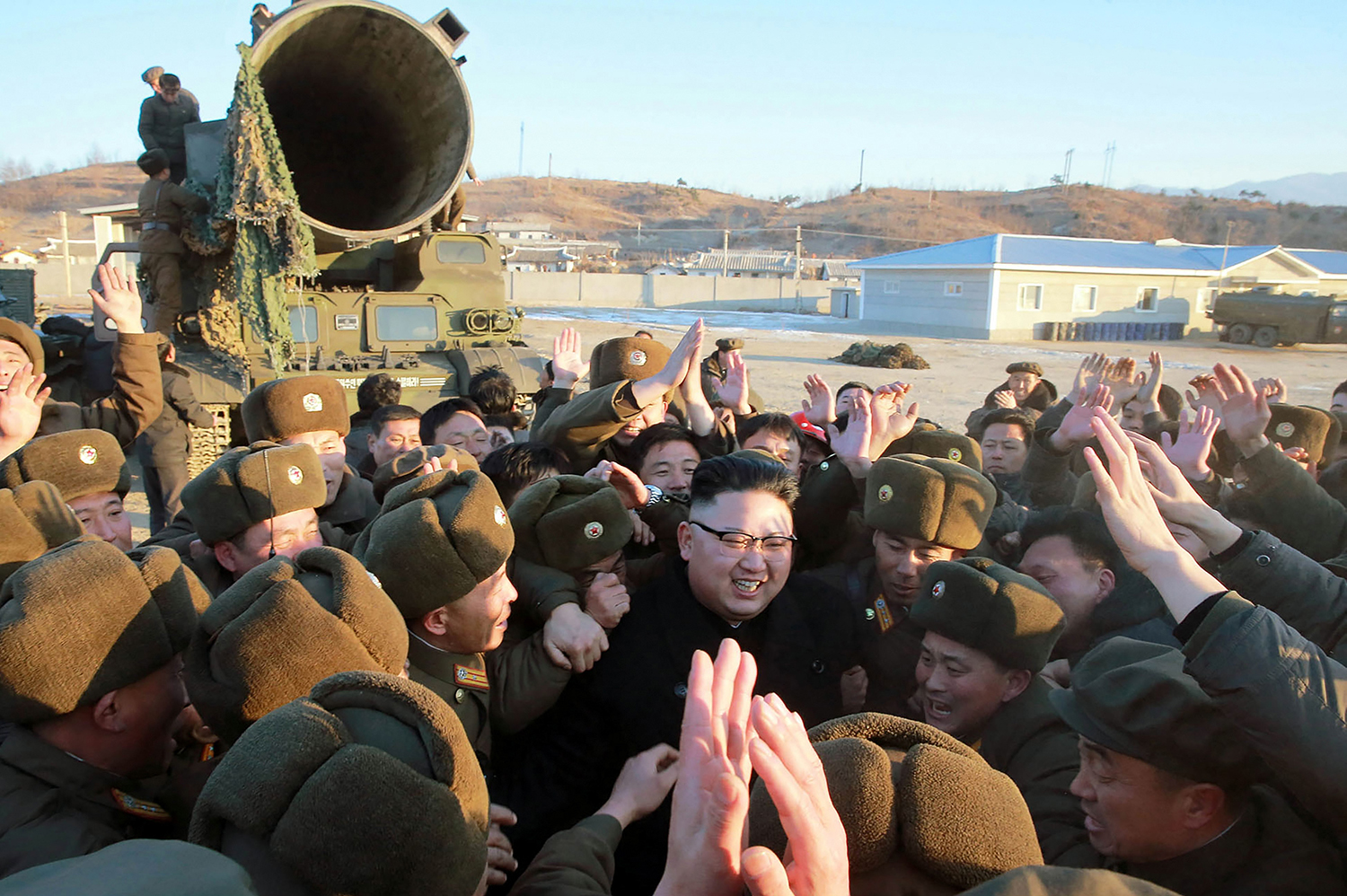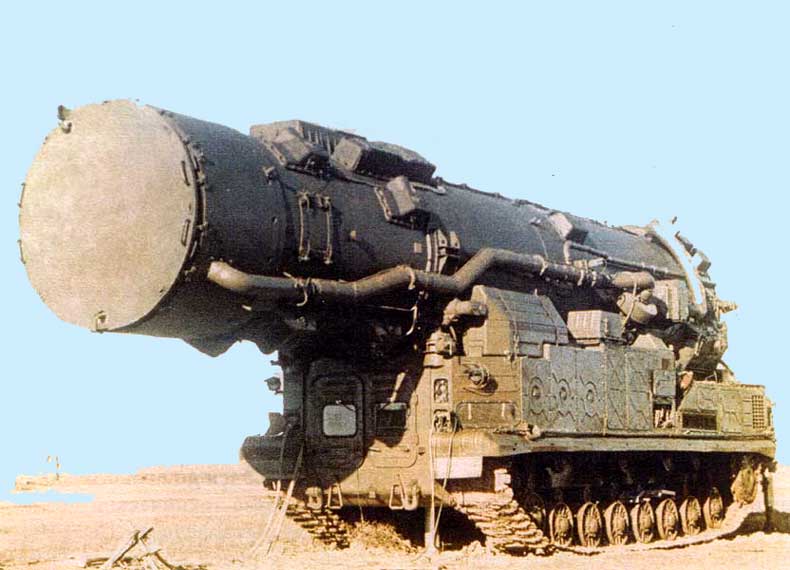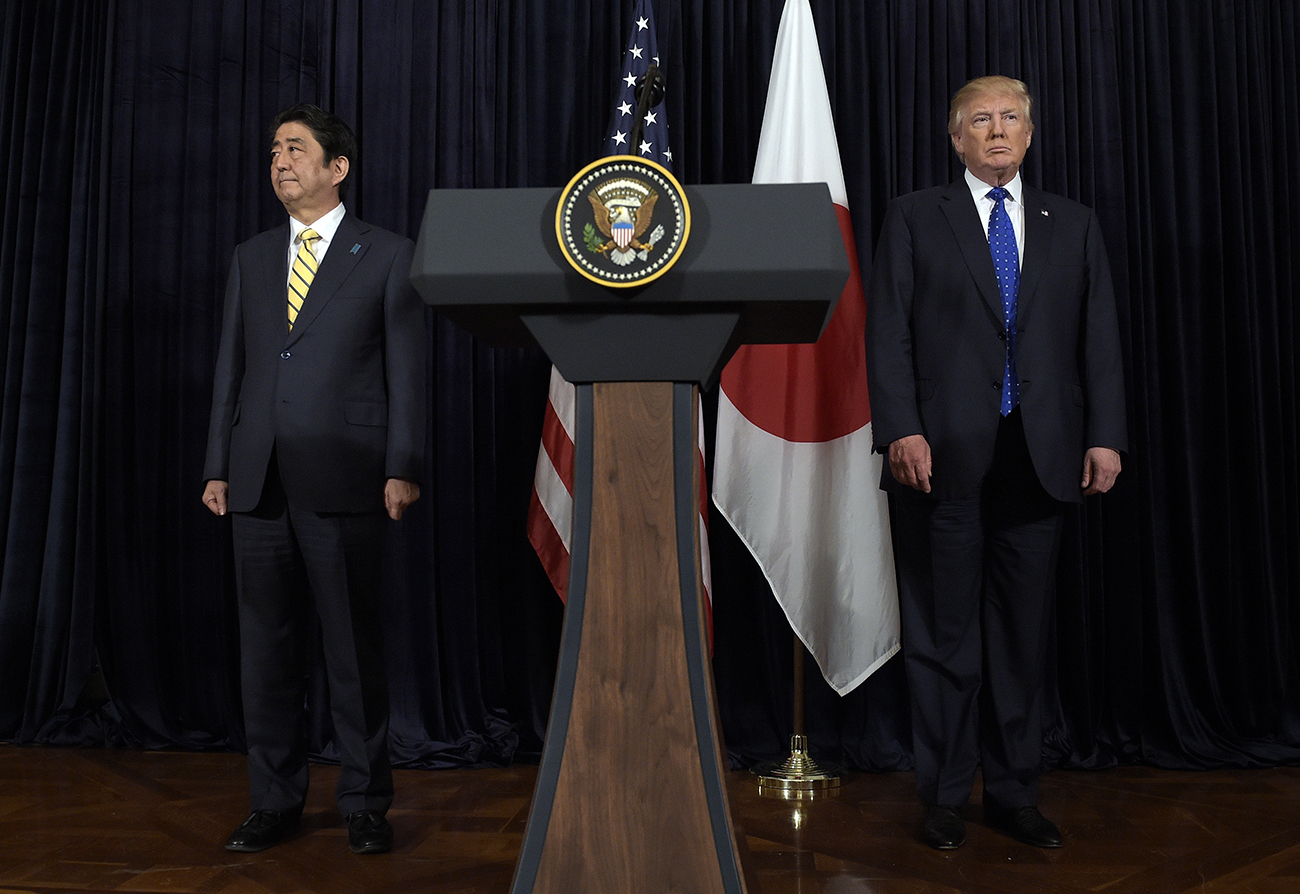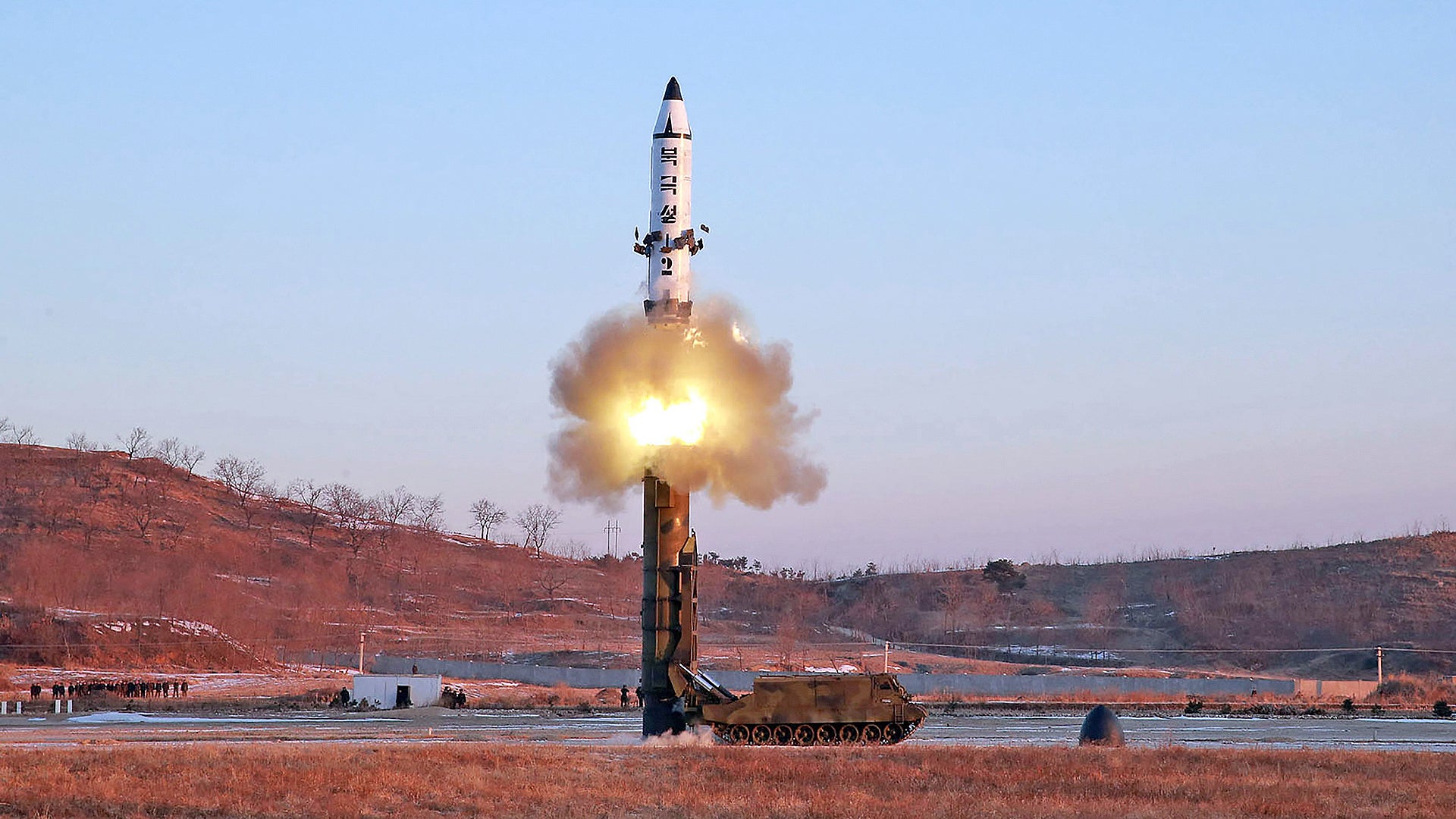As we reported on January 3rd, Kim Jong Un promised that a test of a new advanced ballistic missile system would occur in the near future. As President Trump ended his third week in office, and as Japanese Prime Minister Shinzo Abe made a state visit to Washington DC and to Trump’s self proclaimed “Winter White House”— his Mar-a-Lago resort in Palm Beach, Florida— Kim Jong Un made good on that promise.
As the sun came up in northwestern North Korea, under the gaze of the young tyrant Kim Jong Un, a missile canister hinged upward from the back of a never seen before transporter-erector-launcher (TEL) and let loose its payload. The stout rocket levitated into the air before its motor ignited and it started a steep parabolic trajectory flight. Minutes later the rocket splashed into the Sea of Japan roughly 300 miles from its launch point.


Word of the launch came shortly before Trump and Abe, along with their delegations, sat down for a candlelight dinner at the resort. Flash briefings of what had happened supposedly came in the form of printed memos that were distributed to both teams, sending aids running for better light and using the glow of their cellphones (probably not the most secure thing to do) to read what the intelligence report said. Supposedly this moment was caught in the photo below taken during the lavish evening.
A statement by both leaders quickly followed, with Trump stating the US would back Japan “100 percent.” This was likely a welcome statement for many Japanese to hear after Trump questioned America’s military commitment to Japan during the election cycle.
Examining the footage from the launch, what’s far more impressive than the missile’s flight profile was how it made its way out of its canister. Instead of blasting off under the power of its own engines from a vertical position, the missile was “cold launched” into the air using compressed gas, after which its motor ignited and it successfully began its climb.
Cold launching is a hard capability to master, but if perfected it can result in a lighter, longer-ranged missile that can be deployed very quickly, as well as a less weighty TEL. Cold launches also feature a “cleaner” launch sequence with less localized impact, and allows for launches in tighter spaces. On the other hand, if the missile’s fuel and rocket systems are not reliable, a cold launch of a solid-fueled missile can be more dangerous than a liquid-fuel missile that uses the hot launch method. This is because once the missile is ejected during a cold launch, if its motor fails to start as timed it will fall back down on the TEL and explode. Cold launch systems can also have wind limitations as well, although this may not be an issue for such a heavy missile.
Also of interest was the missile itself, which looked very much like the two-stage KN-11 “North Star/Polaris” submarine-launched ballistic missile (SLBM) that North Korea had tested on multiple occasions last year. Its flight profile was also very similar. This potentially land-based variant of the KN-11 is being reported by North Korean media as having the designation “Pukguksong-2.” Its name is immaterial, but what does matter is the fact that it seems as if the North Koreans have begun to master the use of solid rocket propellants.
Just nine months ago, as it was becoming clear Pyongyang’s missile development strategy was dramatically changing, it was thought that North Korea was in the beginning stages of applying solid-fuel technology to their ballistic missile systems. Now it seems glaringly possible that they have actually achieved initial functionality of solid-fuel designs, both those that can be launched from land-based TELs and from submarines.
As The War Zone reported last May:
“Ballistic missiles that use a solid-fuel based propulsion concept can be stored for long periods of time with little maintenance requirements and can take much more abuse while remaining mission capable. Most importantly, they can be launched much faster than their clumsy liquid-fueled counterparts. However, the propulsion technology behind solid-fueled missiles is much more challenging to master.
It is known that North Korea has been testing solid fuel rocket engines. If one of these adolescent engines was fitted to the submarine-launched missile that was tested recently, it is possible it’s flight was short because the limitations of this early iteration of a solid fuel propellant and motor. If this is the case, it’s likely that the goal of the test was proving launch capability, not downrange flight capability. The weak thrust of a new solid-fuel motor may have limited the amount of fuel that could be loaded onto the missile. By loading less fuel, the thrust-to-weight ratio required for the missile to fly off after being “cold launched” from its underwater missile tube could be achieved.
If the KN-11 submarine-launched ballistic missile fired late last month had a new solid-fuel based propulsion system, we should be concerned. If North Korea has moved to this more promising but complex rocket technology, it will have repercussions across each of their ballistic missile and rocket programs. Once mature, this technology would signify a giant leap in reliability and quick-launch capability for Pyongyang, and it would align with its stated goal of creating a credible nuclear deterrent as quickly as possible. It could also mean that the deployment of nuclear armed ballistic missiles on future North Korean submarines is entirely plausible.”
Kim Jong Un appears to celebrate with troops after the launch, the empty TEL looming in the background (STR/AFP/Getty Images):

Although North Korea claims this is a long-range ballistic missile, its actual range still seems limited to below that of an intermediate range ballistic missile—say roughly 800 miles on a minimum energy trajectory. This still puts South Korea and much of Japan within its reach. As such, this is really a theatre ballistic missile as much as anything else, but using a more rigid rubric, it likely sits somewhere near the bottom of the medium-range ballistic missile designation spectrum.
Regardless of its current range capabilities, if last year was any indication, North Korea will likely make massive strides this year in creating better solid fuel propellants and motors that will take their missile designs on increasingly longer-range flight profiles. Also, the cold launch capability may be limiting how much fuel North Korean missile testers load onto these KN-11 derivatives. But even if the missile’s range does not increase, it can fly far enough to take on North Korea’s most pressing military capability—that of a quickly deployable, robust nuclear delivery system that can hit targets that are on the top of Pyongyang’s priority list.
North Korea acting quickly to extrapolate its most mature solid-fuel ballistic missile system from the sea to land makes a lot of sense. Building a capable fleet of submarines that can deploy ballistic missiles in relevant numbers is a longer-term and much more costly goal than building TELs that can move similar missiles around the North Korean countryside.
Land-based ballistic missiles traditionally don’t offer a credible “second-strike” deterrent compared to their submarine-based counterparts. But a road-mobile, solid-fuel missile like this one does provide a much more elusive and tactically relevant baseline nuclear weapons delivery capability than North Korea’s more cumbersome liquid-fueled ballistic missiles. The fact is that even if North Korea could potentially deploy the same ballistic missile on a small fleet of diesel-electric submarines, those submarine would likely be continuously hunted and tracked by US, South Korean and Japanese submarines. As such, the chances of one actually getting off a shot before being sunk is questionable at best. As such, putting more resources into deploying a land-based KN-11 in the short term, and working to develop a submarine-based second-strike deterrent over the long term makes great sense.
As we discussed earlier, liquid-fueled missiles take time to fuel in their launch position, leaving them especially vulnerable to detection and attack by US and South Korean forces. If this land-based KN-11 derivative indeed runs on solid fuel, that would mean that it can be launched in a matter of minutes from the back of its TEL. This ability to “scoot-n-shoot” makes it a far larger threat than anything that came before it within North Korea’s strategic arsenal.
By mirroring the submarine-launched KN-11 program, Pyongyang can bring a land-based solid-fuel missile online quicker than by developing two separate systems independently. Also, by combining efforts, both versions of the missile can develop far faster than otherwise. Paired with a proven nuclear warhead, an operational version of this system could give North Korea its first robust nuclear deterrent capability. Also, by pushing forward with a relatively mature, shorter-ranged missile like this one, North Korea can take more time developing longer-ranged ICBM.
Another peculiar thing about this new missile system is that its transporter-erector-launcher is tracked instead of wheeled. There is some precedent for such a strange setup though. The short-lived, Soviet RT-15/SS-14 “Scamp/Scapegoat,” and RT-20/SS-15 “Scrooge” missile systems from the 1960s had a similar setup, and used a T-10 tank chassis for the TEL’s mobile base. North Korea’s tracked TEL seems to be a unique design, although that could change as more time for research is available. As with most things North Korean, it is likely adapted from something similar.
Photo of ’60 vintage SS-14 TEL:

While technological evaluations of this new missile continue, countries around the world and in the region scorned the launch, although China was much lighter in their condemnation. Chinese Foreign Ministry spokesman Geng Shuang publically stated:
““We will take a constructive and responsible part in the relevant discussion… Under current circumstances, relevant sides should not provoke each other or take actions that would escalate tensions on the Korean Peninsula… As I have pointed out repeatedly in the past, the root cause to the North Korea nuclear missile issue is the conflicts between North Korea and the United States, as well as between North and South Korea.”
Japan, the US and South Korea have called for an emergency meeting of the UN Security Council to discuss the test and what actions that can be taken against Pyongyang for its continued violation of UN resolutions. International action or inaction aside, this latest launch will test the Trump administration which has yet to put forward a hard policy regarding North Korea.

In the past, candidate Trump showed great concern and also a strange form of admiration for Kim Jong Un. Trump even said he would try to engage the “Young General” in unilateral negotiations, although this is highly unlikely to happen.
President Trump could try to make some sort of deal with Beijing—which North Korea relies on for everything from grain to energy imports—whereby the US turns its head on a strategic issue in exchange for Beijing dramatically reining in Pyongyang. This could even be tied to President Trump’s stated hot-button initiative to rebalance trade with China.
Still, it is unlikely China would give away their “Kim card” as part of a trade negotiation alone. Even the US agreeing to shelve its THAAD ballistic missile interceptor deployment plans to the Korean Peninsula would likely be too little for China to fully attack the issue head-on. Something much more controversial would likely be the price of such an extreme change in policy—like the US looking the other way when it comes to China’s man-made island building campaign in South China Sea and their territorial claims to the region, packaged with a series of maritime navigation assurances. Whether the administration would actually execute such a deal is unknown, but Trump is all about making deals, and asking China to change North Korea’s attitude on a drastic scale will take a big sacrifice in return.
Contact the author: Tyler@thedrive.com
